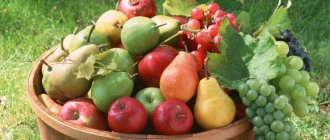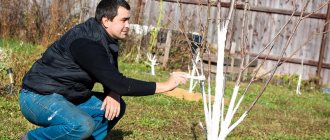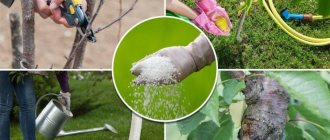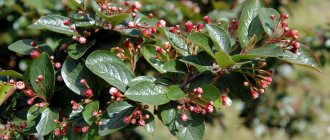- September 4, 2018
- Trees and shrubs
- Ksenia Gubenko
In this article we will talk about how to plant an apple tree in the spring step by step. Gardeners unanimously insist that grafting is one of the most effective ways of propagating shrubs and fruit trees, which, thanks to this method, can not only be significantly rejuvenated, but also diversify the culture of fruit trees. In the article you will learn about when you can graft an apple tree, as well as the main methods for carrying out this work.
Grafting can be done even on small plots of land. This wonderful creative process will allow you to diversify the range of fruit crops in the garden and give a second life to trees. For beginners, grafting apple trees in the spring can cause a lot of difficulties and questions. Professionals advise following the necessary recommendations and clearly established deadlines, and then everything will work out.
What are the benefits of vaccination
It lies in the fact that thanks to this simple process, about ten thousand new varieties of apple trees, pears and other fruits were developed. Amateur gardeners and breeders very often experiment with creating new species. The benefits are as follows:
- The new subspecies quickly adapts to the soil.
- Helps in increasing productivity, namely, the quality improves and the quantity of fruits increases.
- There is no need to uproot trees that do not bear fruit well, as this will take a lot of time and effort.
- The configuration and dimensions of the crown will change.
- A cutting can be purchased completely free of charge or for a symbolic price rather than buying an expensive seedling.
- The winter hardiness and drought resistance of trees increases.
- On one trunk you can grow several varieties at once, for example plums, pears and other fruits.
- This rare variety can be propagated in sufficient quantities.
- Renew and rejuvenate an old tree that has suffered from adverse external environmental factors.
- Combine several (in most cases up to five varieties) on one seedling, which will save space on a limited plot of land with this simple procedure.
- It is believed that only this method can zone a variety of fruit tree that is intended for other climatic conditions.
- This is a unique opportunity to revive an old tree by grafting and give it longevity.
Therefore, when wondering whether it is possible to graft a pear onto an apple tree, there is no need to doubt it - of course, yes. This process only seems complicated at first glance, but it is not. The main thing is to strictly follow the deadlines recommended by experienced gardeners and listen to advice.
Apple tree grafting by copulation
Copulation gives the highest survival rate and is easy to perform. It consists of connecting two cuttings - a scion and a rootstock - by placing their oblique cuts on top of each other. Therefore, it is important that the diameter of the cuttings matches. Its optimal thickness is like a pencil, about 10 mm in diameter.
It is better to choose an annual cutting as a rootstock, but not a top. Although the latter is strong in development, its buds are located too widely.
The scion cutting, in addition to having an equivalent diameter, must have a length of up to 10 mm and developed buds. Both freshly cut and cuttings prepared in the fall are suitable. Only those that have been stored need to be soaked for 3 days.
You can graft an apple tree by copulation from the second half of March. By this time, the rootstock may already be emerging from its dormant period. But the scion cutting must still “sleep”.
Copying step by step
The procedure is as follows:
- Shorten the scion, leaving no more than 4 buds. If there are too many of them, it will be more difficult for the branch to take root. Under the lower bud, retreating 1.5 cm, make an oblique cut at an angle of 25°. Stepping back 1 cm from the upper bud, make a blunt cut at 45° above it
- At the rootstock, cut off the top of the young central shoot or the branch chosen for grafting. The length of the cut should be at least 3 times greater than the diameter of the shoot.
- Connect the scion to the rootstock so that the cambial layer matches as perfectly as possible. Or at least connecting them along the bark on one side.
- Wrap the grafting site tightly with electrical tape, leaving the buds exposed.
To prevent moisture evaporation, it is advisable to apply garden varnish over the binding. The grafting will be considered successful if after 14-15 days the buds on the scion begin to open.
Fruit tree grafting time
It will depend on weather conditions and the type of plants. Experienced Russian gardeners in most cases carry out grafting on warm days, or rather in the spring in April-May. This is due to the fact that during this period the buds swell and sap flow begins, due to which the survival rate of the crops will be the best. And dry summer air has a bad effect on the development of the grafted cuttings.
Beginning gardeners think about how to plant an apple tree in the spring, because it seems to them that throughout the summer the seedling has a lot of time to gain strength and get stronger, as well as adapt to the local climate and calmly endure the cold in winter. Before starting work, you should pay due attention to the weather forecast for two weeks ahead. Since spring frosts can cause great harm to your work.
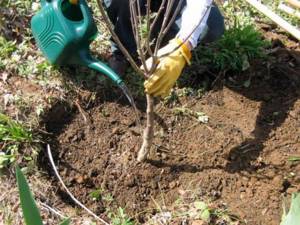
You can enjoy the work done in the shortest possible time - this is exactly one of the advantages of vaccination in the spring. Since after two weeks the implanted graft is clearly visible. Vaccination at any other time of the year will take several months. The timing of vaccination depends on climatic conditions (since warming is different in each region). The best reference point is the kidneys. Because it is imperative to finish the gardening work before they bloom.
In most cases, active sap flow begins towards the end of April. In the southern regions of our country, apple tree grafting (in spring) begins a little earlier, from the end of March. There are times when amateur gardeners only have a few days. Therefore, you need to have time to prepare the rootstock, cuttings and all the necessary tools for working with fruit trees.
Features of spring vaccination

Propagation by splicing is performed at different times of the year. Under certain circumstances, it can be done even in winter. But it is best to vaccinate apple trees in the spring. This also applies to all other fruit trees.
Goals of vaccination
It is difficult to find an agrotechnical measure that had such a number and such a variety of effects as grafting. Experienced gardeners always use this method of propagation, rejuvenation and renewal of varieties to achieve a variety of goals.
It may be interesting How to prune a young apple tree in the fall: a guide for beginnersHow and when to prune Siberian apple trees in the fall so that there is a good harvestFeatures of spring pruning an apple tree: a guide for beginners
Apple trees and other fruit trees are grafted to:
- Get the harvest faster. Apple trees grown from seeds begin to bear fruit only after 10-15 years. Thanks to grafting - on an old tree or seedling for 2-3 years, apples can be harvested after 2-3 years.
- Quickly obtain an apple tree with certain varietal characteristics. If a gardener wants to “clone” a variety he likes, he can not buy a seedling, but graft it by taking a cutting from the desired apple tree. This is especially convenient if the gardener does not know the name of the variety.
- Use your garden space sparingly. Several cuttings from different varieties can be grafted onto one apple tree at once.
- Replace one variety of apples with another, more successful one.
- Retain the variety if the tree is damaged. If your favorite apple tree has been attacked by rodents, sunburn, or root diseases, there is a high risk of its death.
- Grow southern varieties in more severe conditions. If you graft their cuttings onto the trunks of frost-resistant varieties, you can get the fruits of apple trees that do not grow in cold climates.
- Increase fertility and rejuvenate an adult apple tree.
- Extend the fruiting period of a single tree. Since varieties with different ripening periods can be grafted onto one apple tree, the harvest stretches over several weeks.
Optimal timing
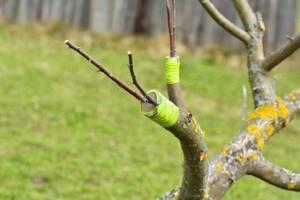
Spring grafting on apple trees is carried out at the very beginning of sap flow. During this period, the tree has not yet fully woken up. When a tree “sleeps”, then all the processes occurring inside it only support its vital activity. If you graft an apple tree in early spring, before the growing season has begun, the scion will not take root.
How to determine the timing for grafting an apple tree:
- the buds are slightly swollen, but active growth has not yet begun;
- the branches became a little reddish;
- if you tear off a piece of bark, it will separate along with the cambium.
In the spring, an apple tree can be grafted with cuttings when all the listed signs are present. This usually happens at the end of March or beginning of April. More exact dates depend on the climate in the region and the current weather. In the south, an apple tree can be grafted even in mid-March, but in Siberia the event is postponed until mid-April.
Budding or eye grafting is carried out later - around April or early May. Plus they focus on the weather. Budding is carried out after complete elimination of return frosts.
On a note!
Vaccination is carried out in cloudy weather, without rain or wind, in the morning or evening.
Benefits of spring vaccination
Spring is not the only time suitable for merging a scion with a rootstock. This procedure can be carried out at any time of the year, but only the spring procedure can ensure maximum survival of the scion.
Advantages of spring vaccination:
- Compared to summer and autumn grafting, manipulation carried out in the spring is several times more effective.
- In spring, there are optimal temperatures for the scion to take root. Too hot summer temperatures, as well as too cold autumn temperatures, can negatively affect the grafted materials.
- If the scion does not take root, the gardener has time to re-manipulate.
Features of the procedure in other seasons:
- Winter. It is carried out only at positive temperatures - indoors. This procedure is called “desktop”. It is only suitable for seedlings that are planned to be planted in the spring.
- Summer. Acceptable, but not popular. The survival rate of the summer vaccination is significantly worse than with the spring procedure.
- Autumn. It is carried out forcedly, since in the fall the survival rate is low. It is carried out, for example, if you need to graft a rare variety, but there is no way to store it until spring.
When carrying out vaccinations, many gardeners rely on the lunar calendar. This procedure is recommended to be carried out on the waxing moon.
Which trees are suitable for grafting in spring?
The most successful seedlings for it are:
- Pear. Many people wonder whether an apple tree is grafted onto a pear tree. Certainly. Also, these cultivated varieties would be a good option: the unpretentious and durable “forest beauty”, the frost-resistant and high-yielding “thin branch” and the winter-hardy “severyanka”. Ussuri pear is suitable as a rootstock. Due to the fact that it can withstand any frost, it is worth considering the fact that not all varieties will be able to take root. Before you begin, you need to thoroughly study the characteristics of the pear and select cuttings with a similar fruiting period.
- Apple tree. It is with this that gardeners very often experiment. Because this fruit tree improves the quality characteristics of the rootstock. Fruit trees such as the Cathedral, Vityaz, Antonovka and wild apple trees are also suitable. Thus, you can graft a pear onto an apple tree
- Red-fruited rowan. This crop survives even the most severe frosts quite steadfastly. Serves as a very good rootstock for late-ripening pears and apples. It is worth noting the fact that the taste of fruit may change (become tart and sour).
- Hawthorn. It is this that provides drought resistance. Feels great on sandy (depleted) soil. Its only drawback is that it has thorns.
- Quince. The taste of pears and apples after grafting with this crop noticeably improves.
- Round-leaved (or spicate) irga. It is quite often used by gardeners as a rootstock. The result is a very colorful hybrid, but it is short-lived.
- Chokeberry (chokeberry). If you cross a pear or apple with this crop, you should take into account that the plant will be dwarf, but short-lived.
- Cherry plum. It is this stone fruit that will become an excellent rootstock for a pear or apple tree. The hybrid is unpretentious, it bears fruit quite early and has a compact crown.
Before starting work, you need to know what a scion is - this is a certain part of the donor plant (they use a bud, branch or cutting), budding (grafting with one bud), copulation is a grafting using exclusively cuttings, and a rootstock is the name of the plant to which they will be attach part of the donor plant. Before you plant an apple tree, you need to figure out what tools you need.
Necessary materials and tools for work
The equipment should always be near you during the work process. To do this, it is better to have a purse or box so that at the necessary moment you will not be distracted by searching for electrical tape or a knife. In order to plant an apple tree on time, you should stock up on some tools. These include:
- sharp knife;
- garden var;
- several meters of polyethylene;
- hacksaw (to cut down thick branches).
Since the beginning of breeding work, this entire set of tools has been used. But progress does not stand still; now the grafting pruner is actively used. Its advantage is that it has minimal risk of injuring the seedling.
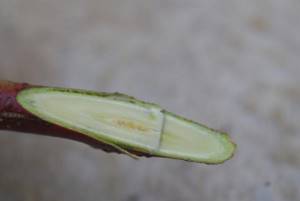
It differs from a regular pruner in the shape of the blade, the advantage of which is its shaped cut. Allows you to make a precise cut on the cutting and a mirror cut on the rootstock. The halves will connect accurately and firmly. With its help you can do:
- budding;
- a cut with a groove (the handle is then installed into it), and the handle is cut so that it fits freely into the groove.
Specialized stores for gardeners offer quite a lot of different models of grafting pruners, ranging from amateur to professional. They differ only in their ability to cut different diameters and the country of manufacture (tool assembly and steel quality). Experts recommend purchasing models with a limit of 10 to 12 mm. Below is a video of how experienced gardeners graft apple trees. They will tell beginners how to use a regular pruning knife.
How to choose the right rootstock and scion?
In order for apple tree grafting to be successful in the spring, the tree must be chosen correctly. First of all, you should pay attention to some characteristics of the rootstock. It should be:
- healthy;
- without dry branches;
- bark without damage;
- it is necessary to have good winter hardiness.
Both mature and young trees can be grafted. If a gardener has a goal to modify a seedling, it is better to do this before it is three years old.
Getting a good result will depend on the correct choice of rootstock and scion. The first one must be healthy, mature, bearing fruit for at least two years and resistant to disease, located on fertile soil. For the procedure, you should choose low-wind areas of the crown with good sunlight. And as a scion, it is better to use cuttings of new resistant varieties of domestic fruit trees.
Only after we have properly grafted the apple tree can we safely expect a new harvest of interesting fruit flavors. The optimal scion and rootstock should be from related varieties. This is what will guarantee compatibility. But this statement is controversial, since wild animals can also be vaccinated and domesticated.
Preparing the scion for grafting
As we figured out a little earlier, a scion is a specific variety of apple tree cutting that must be selected in advance. Before grafting an apple tree (in spring), you should properly prepare for the process. You need to cut the cuttings immediately before starting work.
Damaged branches and diseased apple trees cannot be donors for grafting. Tops (empty shoots) are also extremely undesirable. It is easy to distinguish them from ordinary shoots. The buds on them are quite small and they are located less frequently than on the branches, which are ideal for grafting. Apple tree cutting dimensions:
- length varies from 15 to 30 cm;
- thickness - from 0.8 to 1.5 cm.

It is worth paying attention to the fact that the material must have from three to five healthy and well-developed buds. You can divide one shoot into several cuttings. The main thing is that they have the required number of buds. As soon as the cuttings are cut, they must be left in honey water. Recipe:
- you will need 0.5 liters of warm (boiled) water;
- honey - 1/2 teaspoon.
After dissolving the latter, it is necessary to place the cut scions into the prepared container. This is what will increase all chances of survival and preserve the cuttings until grafting. If, due to unforeseen circumstances, the tree is located far away, and it is not possible to cut and graft a shoot on the same day, you can store the cuttings in a plastic bag in the basement or refrigerator at a temperature of - 1 to +5 ˚С).
Experienced gardeners advise beginners not to hesitate if the material has already been prepared. After all, the less time between cutting and grafting, the higher the chance of the cutting taking root. You can see in the video below how apple trees are grafted, but strengthening your knowledge from various information sources will not hurt.
Sequence of work execution
It is convenient to graft apple trees when the scion and rootstock are not thick. It is best to work with one-year or two-year-old material. It is more difficult to splice thick branches, since it takes longer to adjust the cut points. The procedure consists of the main steps: splitting the rootstock, preparing the scion, aligning and isolating the area to be joined.
Preparatory work
The process of grafting an apple tree begins with the selection of a rootstock. The trunk of a wildflower or other suitable seedling is cleaned of dirt, and then a cut is made with sharp pruning shears. A stump 15 cm high remains above the ground. To cut a thick trunk, instead of a pruner, use a sharp garden saw. If the cutting is grafted onto an adult tree, then the branch is cut down. The rootstock should be smooth, clean, with healthy bark without defects or thickenings. To graft one cutting, the rootstock is cut at an angle, and the scion is installed at the top of the cut.
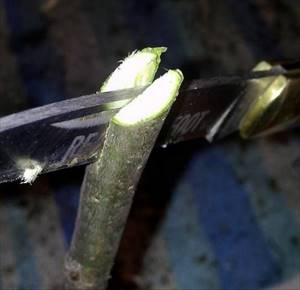
The difficulty of splitting depends on the thickness of the rootstock. A thin branch can be easily divided with a sharp knife strictly in the center. The depth of splitting is about four times the diameter of the seedling.
Splitting a thick branch or stump occurs using a different technology. On the bark of the rootstock at the site of the supposed split, cut the bark with a sharp knife. This must be done on both sides of the seedling along the diameter of the trunk. The cuts will prevent rough tearing of the bark by creating smooth split edges. A sharp knife blade is placed in the center of the rootstock. It should coincide with the cut lines of the bark. Using strong hand pressure, split the wood into two parts. When the knife reaches a depth of 7 cm, a temporary wedge is inserted between the two halves.
Preparation and merging of the scion with the rootstock
Apple tree cuttings are prepared so long that there are three to five buds left above the cut. The excess top is cut off with sharp pruning shears. The bottom of the apple tree cuttings is cut into a wedge shape with a knife. The length of the pointed part is equal to four diameters of the scion.
Attention! Do not touch the cut areas with any objects or hands. It is advisable to wipe the knife blade with alcohol before grafting. Precautionary measures are needed to prevent infection from getting into the vaccine.
When merging young thin branches, a pointed wedge of the cutting is inserted into the split until the cambium coincides. A cut strip of bark from the scion is left above the split for better fusion of the cuttings.

Two thin apple tree cuttings are inserted into a thick stump or branch cut. The graft is placed on both sides of the split. It is important to take into account the different thickness of the bark during such grafting. When splicing, you should not try to combine it. It is more important to take care of the cambium matching.

After combining the scion with the rootstock, the grafting site must be immediately protected.
Isolation vaccination
A small gap remains at the junction of the cutting and the rootstock. The entire area is treated with garden varnish for better healing. Gardeners prepare it themselves, but you can buy it in the store. The split is tightly tied with electrical tape so that the cuttings do not dangle. From above, the entire grafting site is additionally covered with a plastic bag. The film will not allow the cuts to dry out. A humid microclimate will be constantly maintained at the grafting site. On a hot sunny day, shade the grafted apple tree.

Sometimes gardeners even wrap the cutting itself with a special tape. The method is not bad, but you need to handle the buds carefully so as not to break them. The insulation is removed after the scion has engrafted, which is signaled by the blossoming leaves.
In the video, grafting apple trees into clefts in the spring according to all the rules:
Preparing the rootstock for grafting
A suitable rootstock, which can be a stump, tree or seedling, must be prepared in advance. Professional gardeners select a rootstock in the summer, and grafting is carried out in the spring.
Young three-year-old seedlings (apple trees) are ideal for rootstock. It is also recommended to pay attention to wild game, as it grows in the wild in the local climate and is able to resist any disease and pests. Some gardeners grow the rootstock themselves for the desired crossbreeding. To do this, you need to plant any varieties of apples and start grafting after two (three) years.
The use of old wood for rootstock is also encouraged. But in this case it is necessary to remember that it must be healthy. It is highly undesirable to graft onto an apple tree that has been damaged by insects.
If a suitable rootstock is not available, third-party crops can be used, such as:
- pear;
- Rowan;
- hawthorn;
- quince.
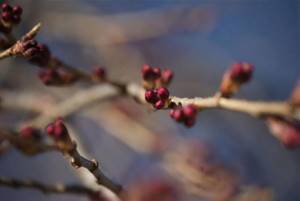
But it is worth remembering that there are often cases when the scion does not take root well. The fruits lose their taste and become small over time. Therefore, a guaranteed option would be to use apple rootstock, since in this case you can consistently get a good harvest of apples.
Care after vaccination
- Do not allow pests (aphids, caterpillars) to appear on the grafts; they are young and tasty.
- Water and feed grafted trees in a timely manner.
- Protect from damage by rodents and birds.
- Regulate the growth of grafted shoots by pinching, bending and bending.
- Loosen the winding in a timely manner.
- Tie up young shoots.
When to remove the harness?
- Loosen or renew the bandage (winding) after about 10-15 days, cutting the film lengthwise with a blade.
- It will be completely removed in two to three months..
- Do not loosen the winding - it may pull the branch.
Apple tree pruning for next spring
Pruning on young seedlings:
- Leave one of the best shoots for each graft.
- Delete the rest.
- Cut out all the growth below the grafting site.
- If growth is good, shorten the branches by one third.
What to do next fall?
- Tie up the grown shoots.
- Water and feed.
- Whiten the trunk and hill it up for the winter.
- Insulate and protect from rodents.
How to trim root shoots at the grafting site?
- All growth below the grafts is completely removed.
- Trim at the base, don't break off.
- The debris further stimulates their growth.
Watch how an apple tree should be grafted onto an apple tree in the spring, a video about care with a 100% survival rate:
And a little more about some of the features of apple tree grafting.
Is it possible to graft dwarf apple trees onto wild ones?
Possible. But not at once.
The scheme is simple:
- A wild dwarf.
- After a year, the dwarf has a good variety, the so-called grafting with an insert.
Apple trees on a dwarf rootstock.
And the result:
- Root system of a vigorous seedling.
- Insertion of a dwarf rootstock (15-20 cm).
- And on top is a cultivated variety.
When talking about apple tree rootstocks, we cannot fail to mention clonal rootstocks. This is a whole group of apple tree varieties for grafting cultivars onto them.
- The apples of these varieties are not only not tasty, but not even very edible.
- They are propagated only by layering, root segments, and cuttings.
But it is not fruits that are needed from them.
They give a good variety the much needed:
- Short stature.
- Survivability.
- Compatibility.
- Precociousness and others.
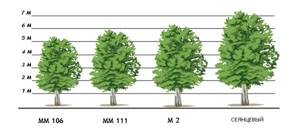
Dimensions of only some clonal rootstocks
Tips for proper preparation
How to plant an apple tree in spring (step by step)? Experienced gardeners recommend using only sharp and disinfected tools to avoid introducing infection into the tree. That is why you should not touch the cut area with your hands. It is recommended to label sprouts of the same variety. The pieces wrapped in tape in a bundle are very easy to store, and the risk of dampness is reduced.
The best place to store cuttings is in the refrigerator or basement. It is necessary to monitor the temperature. If they freeze, it is unlikely that they will produce a good and high-quality scion. Heat is also bad because there is a risk of bacterial contamination and premature germination can occur, making them unsuitable for apple tree grafting. Therefore, the temperature should be carefully monitored, decreasing or increasing it. In the video for beginners, the process of grafting an apple tree will be demonstrated in sufficient detail.
You can also protect cuttings from damage if you monitor the humidity, since drying out will destroy the future scion. And excess moisture will cause mold to appear on the handle, which will make it unusable. In order to determine the optimal humidity level, you need to squeeze the cutting in your fist. The hand should be slightly damp after contact, but not very wet. If mold does appear, you can dip it in one percent alcohol iodine or copper sulfate (the solution should be three percent).
Preparation
Unlike the operation carried out in the summer, when a bud is transplanted, in the spring a fairly large cutting or twig is used, which gives better results in terms of survival and fruiting in the future.
It is best to cut the tree in early winter, when the tree has already gone into hibernation after the first frost, but the operation, which is carried out in early spring before the onset of a thaw, also gives good results.
Before starting the procedure, you will need to thoroughly wash your hands with soap to prevent infection - this precaution should be taken not only when grafting apple and pear trees, but also other trees in the garden.
It would also be a good idea to put on sterile gloves before getting started - getting vaccinated correctly and accurately is almost as difficult as doing a real surgical operation.
After this, select an annual branch about 20-30 cm long, growing upward, and mark the location of the cut - it should be located 0.5-0.7 cm above the point of attachment to the trunk. The best way to make the cut is to use a sharpened grafting knife, which can be purchased at most garden centers.
Carefully cut the bark, trying not to fray its fibers - when transplanting cuttings of an apple or pear tree, this point is very important, since incorrectly cut bark can lead to the entire branch drying out and the grafting to fail.
In photos and videos on the Internet you can see that the cut is made at an acute angle. It is advisable to maintain a proportion of 1:3 - that is, the length of the cut surface should be three times the diameter of the cutting. The upper part should also be carefully trimmed under the bud, being careful not to damage the bark.
It is best to wrap the finished scion at the base with a cloth slightly moistened with water and place it in a box with sawdust located in the cellar or basement. You can also store cuttings in the refrigerator, but for this they must be short.
Choosing a vaccination method
In practice, there are many methods for grafting apple trees in the spring for beginners, among which there are those that require the necessary experience to carry out crossing. Let's consider all the options, starting from the easiest and simplest to complex processes:
- Copulation.
- Cleft grafting.
- For the bark.
- By the bridge.
- Budding.
- Implantation.
- In the side cut.
The most popular and frequently used is the first option – copulation. The method of crossing depends directly on the diameter of the cutting and seedling. If they are different, it is better to use other methods.
We’ll look at how to plant an apple tree in the spring step by step a little later. You need to know one subtlety: crossbreeding should be done in cloudy weather, but not in the rain. If the region is warm enough in the spring, work should be postponed until earlier in the morning.
Method one - copying
The main point of this method is that it is necessary to make identical cuts on the rootstocks and young shoots of the scion. Because then they must connect and be fixed as one branch. The shoot is highly likely to take root if both parts are very tightly connected.
How to graft apple trees in the spring step by step using the copulation method if they do not match in size? This is impossible to do. The thickness of the shoots should be the same - from two to five centimeters. You should choose 1-2 year old trees. Gardeners use two types of copulation:
- simple;
- and improved (for the tongue).
The technique differs only in the method of cutting. In the first case, branches with identical cuts sometimes grow together poorly, due to loose contact of the cambial layers. Therefore, the second method is more often used.

With the “by the tongue” technique, a zigzag cut (or shallow split) is made on the rootstock and scion in order to connect the cuttings as tightly as possible. Let's find out how to plant an apple tree in the spring step by step in a simple way, so:
- Oblique cuts three to four centimeters long (at an angle of 25-30 degrees) are made on the rootstock and scion. Then the cuttings are cut by moving towards themselves so that the cut is even.
- The shoots are connected as closely as possible to each other to form one branch.
- The place where they are connected is wrapped with film or insulating tape and is well fixed.
- Open wounds should be treated with garden varnish.
The result of the work done will be noticeable in two weeks. If everything went well, the buds should swell and small green leaves will appear on the shoots. Experienced gardeners recommend using grafting pruners. Due to the sharply sharpened knives, the cuts are as smooth and perfect as possible.
What is the best time for cleft grafting?
Apple trees are grafted year-round. The best results are obtained in the spring, when the trees are dormant. Success at other times of the year requires gardener experience.
Winter
It is not advisable to vaccinate in winter. It requires a lot of training and experience as a gardener. The trees are in a dormant state. Vaccination is carried out indoors. The scion is collected before frost and stored at 0 °C. Transfer to a warm room two weeks before merging, cuttings - three days. Work is carried out from January to March. Plant in open ground 14 days after grafting and later.
Spring
Spring is the best time for cuttings to take root. The first sap flow begins, which has a beneficial effect on the grafting results. Nutrients accumulate in the tree. Buds and leaves are actively developing. Cuttings are taken from trees older than 3 years in the morning or evening. The air temperature during the day should be about +10 °C. Sap flow is checked by good separation of the bark from the wood.
Summer
In the summer, the second stage of sap flow begins, but it is undesirable to engage in splicing at this time due to poor survival rate. Buds and leaves appear in the cuttings. As a last resort, work is carried out in August during the ripening of the fruits. Shoots will appear only next year.
Autumn
At this time of year, sap flow slows down, and the survival rate of the scion worsens. Splicing work is carried out until mid-October, when the average daily temperature is above +15 °C. Graft onto young rootstocks. Shoots appear in spring.
Method - for the bark
Grafting apple trees in the spring step by step using this method is very difficult and scrupulous. The problem is that the end of the cutting (due to its specificity) cannot fit tightly to the rootstock. Therefore, this method requires maximum care and precision of movement.
The “bark” method is used only in the spring. It is during these days that the bark can be easily separated from the wood. How to plant an apple tree in spring? So:
- Up to four cuttings are evenly grafted onto a rootstock branch. This is necessary so that it is equally overgrown, and subsequently the strongest and most tenacious ones are left.
- Grafting must be done at a height of one hundred centimeters from the surface of the soil on which the seedling grows.
- You need to cut the bark with a sharp knife so that it can easily come away from the wood. The length of the incision should be no more than five centimeters. After which it is necessary to expose the wood by slightly moving the bark.
- An oblique cut is made at the bottom of the cutting; the length must completely correspond to the scion. It is very important to achieve a neat, smooth cut. The kidneys should be pointing upward.
- Then the cutting must be placed under the bark.
- Press the parts very tightly.
- Tie with improvised means.
- Secure the bandage with garden varnish.
This grafting method is aimed at quickly completing the job. Therefore, beginners are not recommended to use this method, but it is extremely necessary to know it. You can tie the parts with strips of polyethylene. But gardeners often use regular electrical tape.
How to plant an apple tree in spring: methods
There are several ways to graft garden crops. You can graft an apple tree:
- By copulation. Cut the shoots of the scion and rootstock equally along the bias and connect them with cuts.
- Improved copulation. Cut a recess on an oblique cut of the rootstock, and a tongue on the scion. Insert the resulting cutouts into each other.
- For the bark. Used for adult apple trees to make them stronger and more resilient. At a height of 1 m from the soil on the rootstock, cut the bark and move the edges apart so that the wood is visible. Cut the lower part of the cutting obliquely. Insert the scion with an oblique cut into the cut in the bark and secure tightly.
- Into the cleft Most suitable for grafting young trees. For the rootstock, choose a strong skeletal branch with a diameter of no more than 5 cm. Make an even cut (cut off the shoot). Split it down the center. Cut the scion cutting at an angle, and the length should correspond to the depth of the split on the rootstock. Insert the cutting into the split, opening it wider.
- Budding or grafting with a bud (eye). An incision is made on the rootstock, into which a bud cut from the scion is inserted.
Let's look at each method in more detail.
Method three - bridge
How to graft an apple tree in the spring using this method, thanks to which the tree is saved? As soon as significant damage from rodents, sunburn or severe frost has been noticed on the seedling, the bridge method is used. You need to select cuttings much wider than the area to be restored.
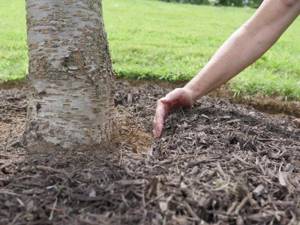
This is done as follows:
- The inflamed area of the bark must be cleaned of all contaminants and wiped with a solution of potassium permanganate (dark red).
- Trim the edges of the bark evenly with a sharp knife.
- Make oblique cuts at both ends of the cutting. Remove buds.
- Make cuts on both sides of the bark and insert pre-prepared scions into them.
- Secure it with adhesive tape and wrap it with washcloth at the end.
- Cover the remaining exposed wood with a layer of garden varnish.
The main task of the bridge is to restore sap flow. Therefore, the new buds that have formed must be removed. We figured out how to plant an apple tree in the spring step by step using various crossing methods. But you also need to know about proper care after the work.
Getting started with the transplant
The optimal time for grafting apple and pear trees is considered to be mid-April - early May, when the trees are almost completely awakened and the process of juice movement begins in them.
Therefore, in early spring, even before the onset of warmth, it is worth checking the scion prepared in advance - if the cuttings become unusable during storage, you will have to do the whole procedure again while there is still such an opportunity. When the right time comes, it will be necessary to repeat the entire preparation procedure again before starting the vaccination.
You should immediately prepare for the fact that all actions will need to be done very quickly - time is of the essence.
Using a sharp grafting knife, you should update the cut on the scion, and also create a place for the rootstock by cutting off a similar branch and making a small split. The junction will need to be coated with garden varnish, and after grafting is completed, it will need to be wrapped with thick plastic film. In some videos you can see that electrical tape is used instead of film, but this solution is fundamentally wrong - the adhesive material destroys the bark and does not allow the branches to grow together, which leads to a significant loss of time and effort.
There is also a way in which you can increase the survival rate of cuttings - to do this, the split in the rootstock needs to be deepened and given a cross-shaped shape. A small cut should also be made on the scion branches - it will act as a hook.
As a rule, in this case, you can graft two cuttings at the same time, expanding the crown of the tree. In the training videos, you can see that this procedure is the most complex of those carried out in the spring, however, if all steps are performed correctly, cleft grafting gives very good results.
Let's give some useful recommendations
After the apple tree has been correctly grafted, after three weeks it is necessary to carefully examine it. The appearance of fresh leaves and the green color of the buds indicates a successful procedure. The harness must be removed after three months. But every week it is recommended to loosen it as needed.
In the spring, before the sap flows, the rootstock should be cut ten millimeters above the graft and the cuts should be covered with garden varnish. All lower branches must be removed. During the growing season, the seedling must be watered abundantly. On numerous videos on how to graft an apple tree, you can study the process in more detail. It is worth remembering that you should not keep the equipment you are using dirty, as it can easily cause infection. The mistake beginners make is that they choose the wrong kidney. It is strictly forbidden to cut off the opened one. This is the main point that must be adhered to when grafting an apple tree in the spring. A video for beginners will help you study this issue in as much detail as possible.





